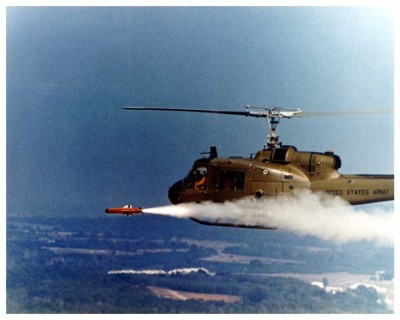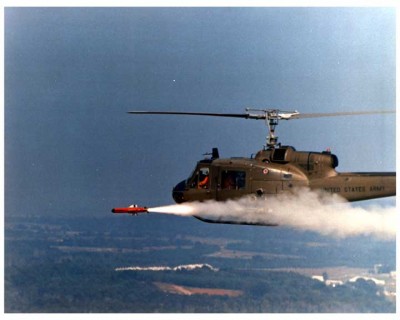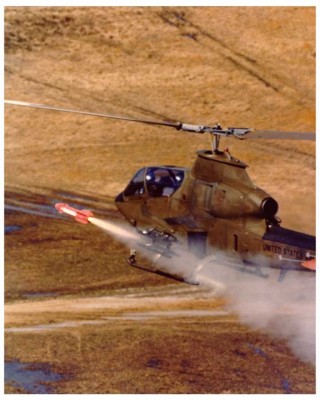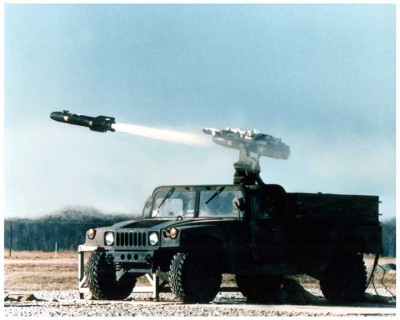Hellfire AGMS (Air-to-Ground Missile Ssystem) is a helicopter missile specifically designed to penetrate thick armour, i.e. against tanks. It can, of course, be used against other resistant targets such as concrete bunkers. The missile's poetic name can again be found in the acronym: HELicopter Launched FIRE and forget missile. Which isn't quite accurate, as I'll clarify below. It is one of the main weapons of the AH-64 Apache and AH-1W Super Cobra helicopters. The Apache can carry up to 16 missiles. Since 1982, over 31,600 missiles were to be produced (by Martin Marietta and Rockwell International).
Over 500 Iraqi tanks were destroyed in Operation Desert Storm Hellfire.
AGM-114A Basic
has been in service since 1982. Currently replaced by the C version, the A is used in live-fire training.
AGM-114B
was designed for the Navy. The missile had additional electronic safety measures for safe operation in the harsh conditions prevailing on board ships.
AGM-114C
was given an improved semi-active laser sensor to increase its success rate in low visibility conditions. The new engine has reduced smoke, making it more difficult to visually detect incoming missiles and reducing (eliminating) the reaction time to some countermeasures. Also, the flight path is lower than that of the A.
AGM-114F Interim
is equipped with a tandem warhead to penetrate armor covered by additional reactive armor. The laser sensor and autopilot are identical to the C version. Production for the US Army ended in January 1994, but continued for foreign customers.
AGM-114K Hellfire II
again has a tandem warhead to penetrate armour covered by additional reactive armour. Compared to the Efk, it has many improvements. Better protection against electro-optical interference, the more sensitive laser sensor can withstand (should, and only with this version) intermittent target irradiation, the problem of unwanted laser scattering has been solved. I have not been able to find out what this scattering is, but it has been identified as the only shortcoming of the AGM-114F used extensively in Operation Desert Storm. The scatter significantly shortens the maximum range of the missile.) The autopilot can be programmed with various forms of flight path.
Combined control system.
Firstly, it is guided semi-actively on the beam of a coded laser, and secondly (passively) by radar - it uses the millimeter pulse radar of the AH-64D Longbow helicopter. The radar, along with a fire control computer, locates, classifies, and prioritizes targets for Hellfire. The missile is not guided by reflected electromagnetic energy, but by data transmitted by the radar. (~which are detected by the radar.) The primary advantages of the Longbow are: independence of weather and light conditions, rain, snow, fog, smoke, battlefield fogging. In service since 1993. Capable
deployable by the Navy.
The target should be irradiated with a laser beam throughout the missile's flight, at any rate in the terminal phase of the missile's flight. Of course, it may not be irradiated by the attacking helicopter itself, but perhaps by a ground marker, a marker on another helicopter,... While the target is irradiated by a well-hidden ground marker, the helicopter can just pop out of hiding, fire the missile, and immediately take cover again. Thanks to the coded laser, several missiles can be fired at several targets in one attack. By the way, the warhead disarms between 150 and 300 metres after launch.
Please take a look at the AGM-64 Hornet, from which the Hellfire is based.
which I have provided data closely related to the Hellfire.
AGM-114C dimensions
Length: 1.63 m
diameter: 17.8 cm
span: 0.34 m
total weight: 45.4 kg
weight of warhead: 9 kg
control system: laser semi-active
engine: TPH rocket engine, Thiokol TX-657 type with reduced smoke
speed: 1300-1500 km/h
range: 8 km
Over 500 Iraqi tanks were destroyed in Operation Desert Storm Hellfire.
AGM-114A Basic
has been in service since 1982. Currently replaced by the C version, the A is used in live-fire training.
AGM-114B
was designed for the Navy. The missile had additional electronic safety measures for safe operation in the harsh conditions prevailing on board ships.
AGM-114C
was given an improved semi-active laser sensor to increase its success rate in low visibility conditions. The new engine has reduced smoke, making it more difficult to visually detect incoming missiles and reducing (eliminating) the reaction time to some countermeasures. Also, the flight path is lower than that of the A.
AGM-114F Interim
is equipped with a tandem warhead to penetrate armor covered by additional reactive armor. The laser sensor and autopilot are identical to the C version. Production for the US Army ended in January 1994, but continued for foreign customers.
AGM-114K Hellfire II
again has a tandem warhead to penetrate armour covered by additional reactive armour. Compared to the Efk, it has many improvements. Better protection against electro-optical interference, the more sensitive laser sensor can withstand (should, and only with this version) intermittent target irradiation, the problem of unwanted laser scattering has been solved. I have not been able to find out what this scattering is, but it has been identified as the only shortcoming of the AGM-114F used extensively in Operation Desert Storm. The scatter significantly shortens the maximum range of the missile.) The autopilot can be programmed with various forms of flight path.
Combined control system.
Firstly, it is guided semi-actively on the beam of a coded laser, and secondly (passively) by radar - it uses the millimeter pulse radar of the AH-64D Longbow helicopter. The radar, along with a fire control computer, locates, classifies, and prioritizes targets for Hellfire. The missile is not guided by reflected electromagnetic energy, but by data transmitted by the radar. (~which are detected by the radar.) The primary advantages of the Longbow are: independence of weather and light conditions, rain, snow, fog, smoke, battlefield fogging. In service since 1993. Capable
deployable by the Navy.
The target should be irradiated with a laser beam throughout the missile's flight, at any rate in the terminal phase of the missile's flight. Of course, it may not be irradiated by the attacking helicopter itself, but perhaps by a ground marker, a marker on another helicopter,... While the target is irradiated by a well-hidden ground marker, the helicopter can just pop out of hiding, fire the missile, and immediately take cover again. Thanks to the coded laser, several missiles can be fired at several targets in one attack. By the way, the warhead disarms between 150 and 300 metres after launch.
Please take a look at the AGM-64 Hornet, from which the Hellfire is based.
which I have provided data closely related to the Hellfire.
AGM-114C dimensions
Length: 1.63 m
diameter: 17.8 cm
span: 0.34 m
total weight: 45.4 kg
weight of warhead: 9 kg
control system: laser semi-active
engine: TPH rocket engine, Thiokol TX-657 type with reduced smoke
speed: 1300-1500 km/h
range: 8 km



